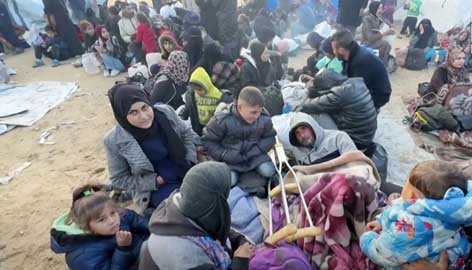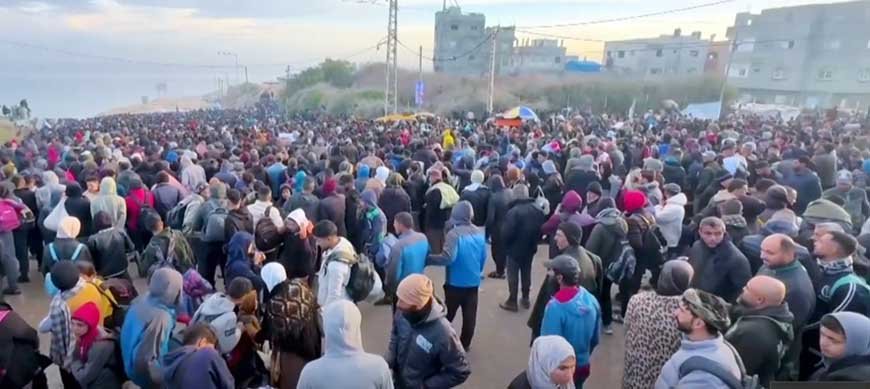January 27, 2025
Former U.S. President Donald Trump has proposed relocating over 1.5 million Palestinians from the war-torn Gaza Strip to Egypt and Jordan in a divisive manner to help to solve the persistent humanitarian catastrophe in the area. Although Trump says this will help to settle things, international organizations, Palestinian officials, Egypt, Jordan, have all turned down the suggestion. Critics contend the proposal runs the danger of aggravating the conflict, undercutting international law, and hampering continuous attempts toward a sustainable truce.
The proposal and its controversy
Fundamentally, Trump’s plan has revived decades-old worries of forced displacement among Palestinians and their supporters. The proposal calls for the inhabitants of Gaza, decimated by years of violence and isolation, to be moved to surrounding nations; Egypt’s Sinai Peninsula and Jordan are possible locations. Proponents of the idea claim it would alleviate the humanitarian situation in Gaza and offer breathing room for diplomatic efforts. Nevertheless, the debate around this idea results from numerous important aspects:
- Violation of Palestinian Rights: Relocating Palestinians would violate their fundamental “right of return,” a principle recognized in international law, especially UN Resolution 194. This right stipulates that Palestinians displaced by the Israeli-Palestinian conflict should be permitted to return to their ancestral lands. Critics argue that Trump’s proposal could permanently strip Palestinians of this right.
- Historical Parallels to the Nakba: The 1948 Nakba (“catastrophe”) saw over 700,000 Palestinians displaced during the formation of Israel. This idea invokes memories of that horrific period, with many fearing a replay of history that might forever destroy Gaza’s Palestinian identity.
- Regional Destabilization: Both Egypt and Jordan face their own issues, including economic pressures, internal political stability, and security concerns. Hosting millions of new refugees will worsen these challenges, potentially leading to social upheaval and political turbulence in these countries.
- Israel’s Role: Critics claim the idea might relieve Israel of its responsibility for Gaza’s present humanitarian crisis. Instead of addressing the fundamental concerns, like as the blockade and recurrent military operations, the policy pushes the burden to neighboring Arab nations.
Linking the Proposal to the Ceasefire Deal
The issue of moving Palestinians is strongly related to negotiations of a sustainable ceasefire between Israel and Hamas. Trump’s idea might theoretically bring short relief to Gaza’s humanitarian catastrophe, which has been a key sticking point in truce discussions. However, the concept complicates rather than streamlines the path to peace for various reasons:
- Displacement as a Pressure Tactic: Trump’s suggestion could be regarded as a kind of pressure aimed at forcing Palestinian officials to agree to a ceasefire under unfavorable conditions. By promoting mass relocation as a potential “solution,” the idea risks sidelining the voices of Palestinians in negotiations.
- Undermining the Two-State Solution: A ceasefire agreement is typically considered as a stepping stone toward a two-state solution. However, mass evacuation would diminish the possibilities of this solution by fragmenting Gaza’s population and making it more difficult to construct a viable Palestinian state alongside Israel.
- Distrust in Negotiations: The idea has aroused mistrust among Palestinians and their sympathizers, who regard it as another attempt to impose solutions without addressing the core causes of the conflict. This misunderstanding might hinder peace discussions and prolong the cycle of conflict.
- Shift in Focus: By advocating for relocation, Trump’s plan diverts focus from the main issues at the heart of the Israeli-Palestinian conflict: the occupation, settlement expansions, and the siege of Gaza. A ceasefire arrangement should attempt to address these underlying problems rather than generating new complexity.

Responses from Regional Players and International Stakeholders
Egypt and Jordan’s rejection of the initiative underscores broader worries about how such a proposal would effect their national security and regional stability:
- Egypt’s Position: President Abdel Fattah Al-Sisi stressed that Gaza is part of Palestinian soil, and evacuating its population would profoundly alter the region’s political landscape. Egypt has generally taken a mediating role in ceasefire negotiations, and Al-Sisi warned that this concept risks eroding its credibility as a neutral party. (Source: Reuters)
- Jordan’s Stance: King Abdullah II highlighted that removing Palestinians would weaken Jordan’s domestic stability and imperil its already poor economic state. Jordan, home to millions of Palestinian refugees, fears that accepting more will strain resources and produce political unrest. (Source: Associated Press)
- United Nations: UN Secretary-General António Guterres condemned the idea, noting, “The focus should be on ending hostilities and addressing the root causes of the conflict, not on forcing Palestinians to leave their homeland.” (Source: UN News)
- Human Rights Watch: The organization labeled the plan “a dangerous distraction” that risks legitimizing forced displacement, a practice illegal under international law. (Source: Human Rights Watch)
Broader Implications for Palestinians and the Region
The probable evacuation of Gaza’s inhabitants would have far-reaching effects, both for Palestinians and the larger Middle East:
- Erosion of Palestinian Identity: Forced removal would weaken the Palestinian presence in Gaza, one of the most symbolically significant places in the Israeli-Palestinian conflict. This would diminish their claims to statehood and self-determination.
- Economic and Social Strain: Host countries like Egypt and Jordan would confront tremendous hurdles in absorbing millions of migrants, causing to economic strain and social conflicts.
- Impact on Future Negotiations: By moving the focus to relocation, the proposal risks sidelining essential problems including the status of Jerusalem, settlement expansion, and the blockade of Gaza—all of which are critical to forging permanent peace.
- International Precedent: If accepted, the idea might create a terrible precedent for handling conflicts internationally, legalizing forced displacement as a “solution” to humanitarian crises.

Conclusion
Trump’s suggestion to relocate Palestinians from Gaza to Egypt and Jordan has intensified the problems surrounding the Israeli-Palestinian conflict and peace efforts. While it is framed as a humanitarian gesture, the plan offers considerable ethical, legal, and political issues. By promoting displacement above resolving the basic causes of the conflict, the idea risks harming the prospects of a sustainable peace and the ambitions of Palestinians for statehood and self-determination.
A ceasefire accord should strive to bring urgent assistance to Gaza while laying the groundwork for a reasonable and durable settlement to the conflict—one that respects the rights and dignity of all parties concerned. This needs resolving the basic concerns of occupation, blockade, and territorial disputes, rather than resorting to actions that may worsen the crisis in the long term.
Related Video (Video Link)
Sources
- Reuters: Trump’s Gaza Proposal Rejected by Arab States
- Associated Press: Egypt and Jordan Push Back on Trump’s Plan
- UN News: UN Chief Speaks on Gaza Crisis
- Human Rights Watch: Forced Displacement Violates International Law
- Al Jazeera: Middle East Reaction to Trump’s Proposal

